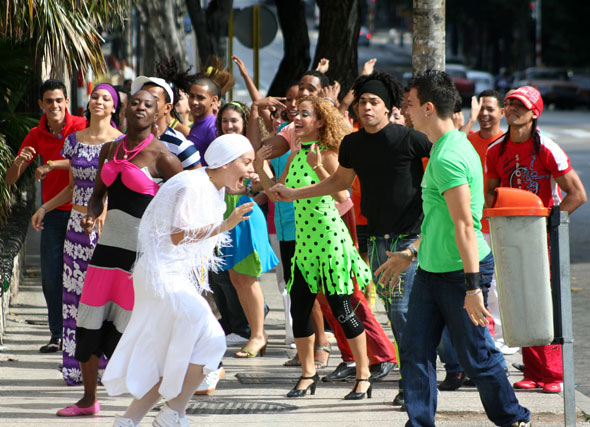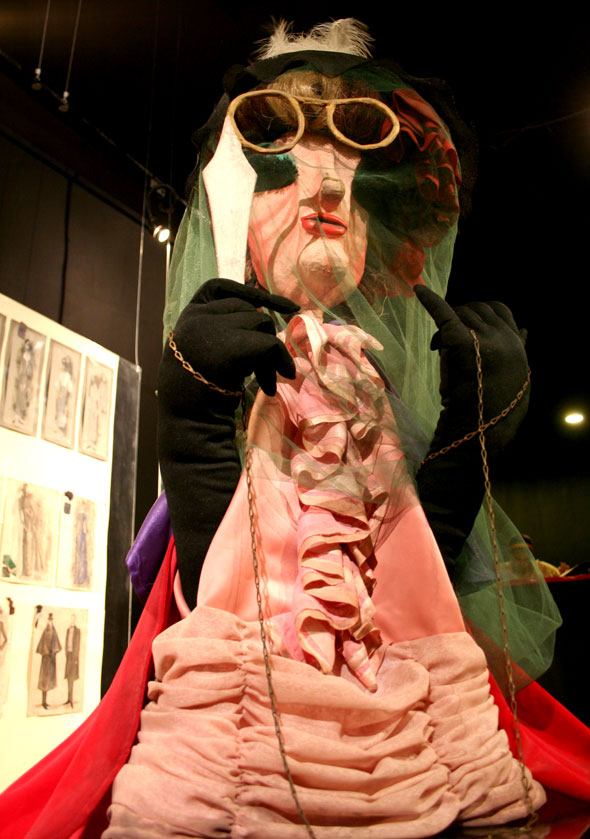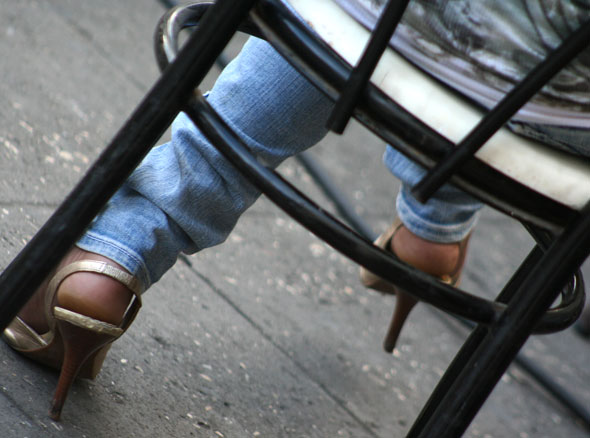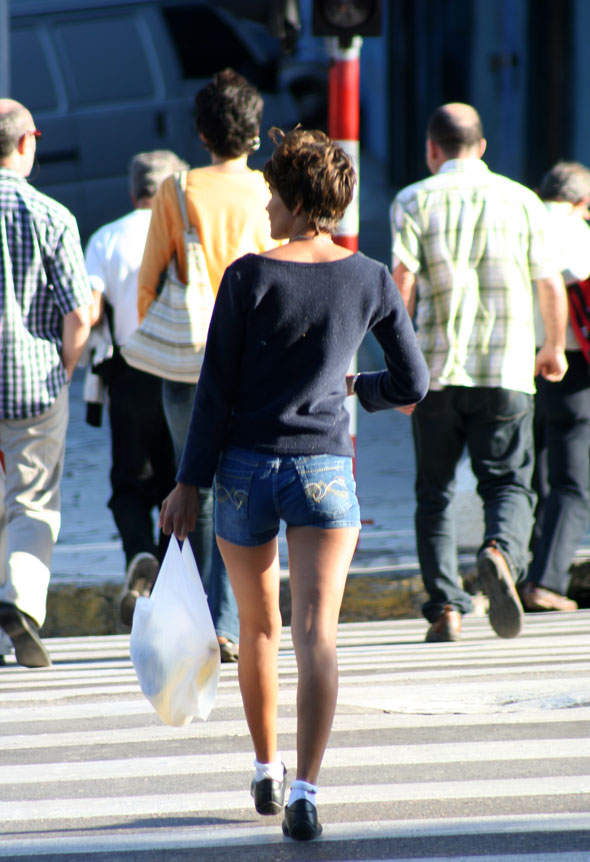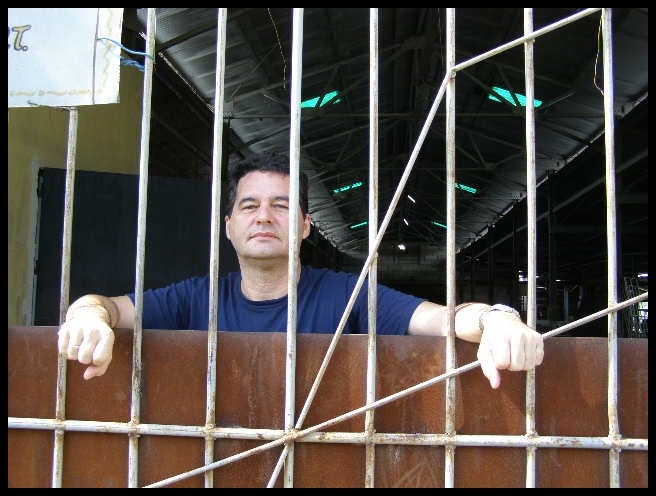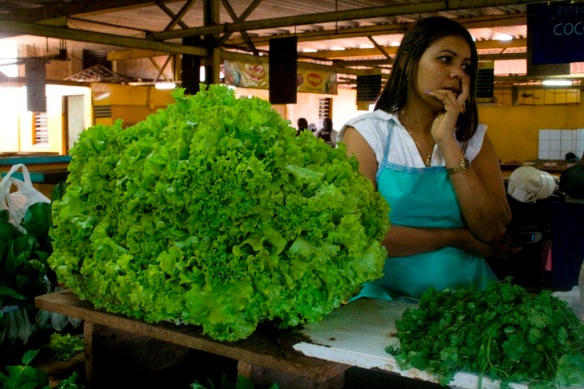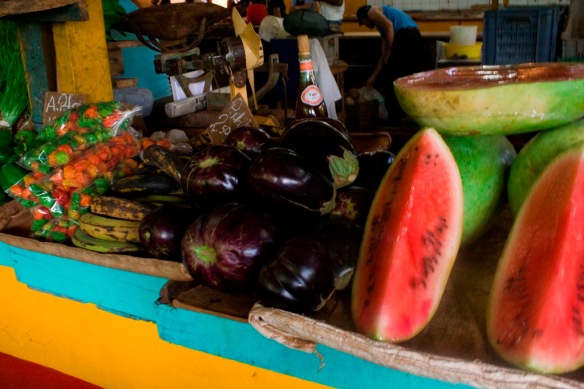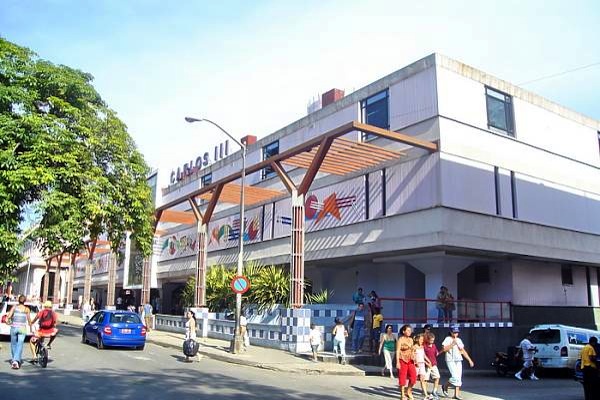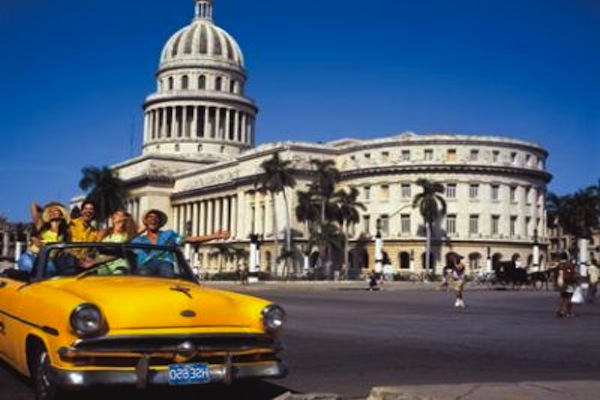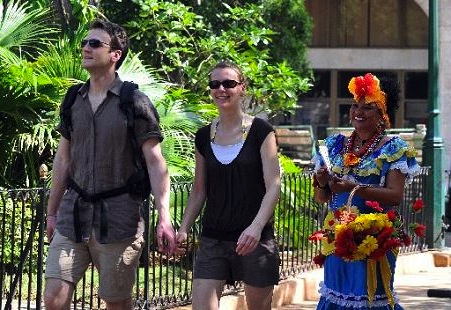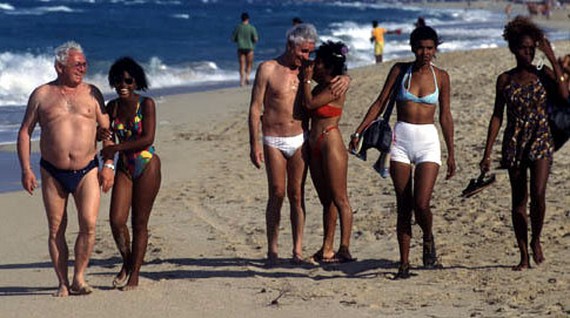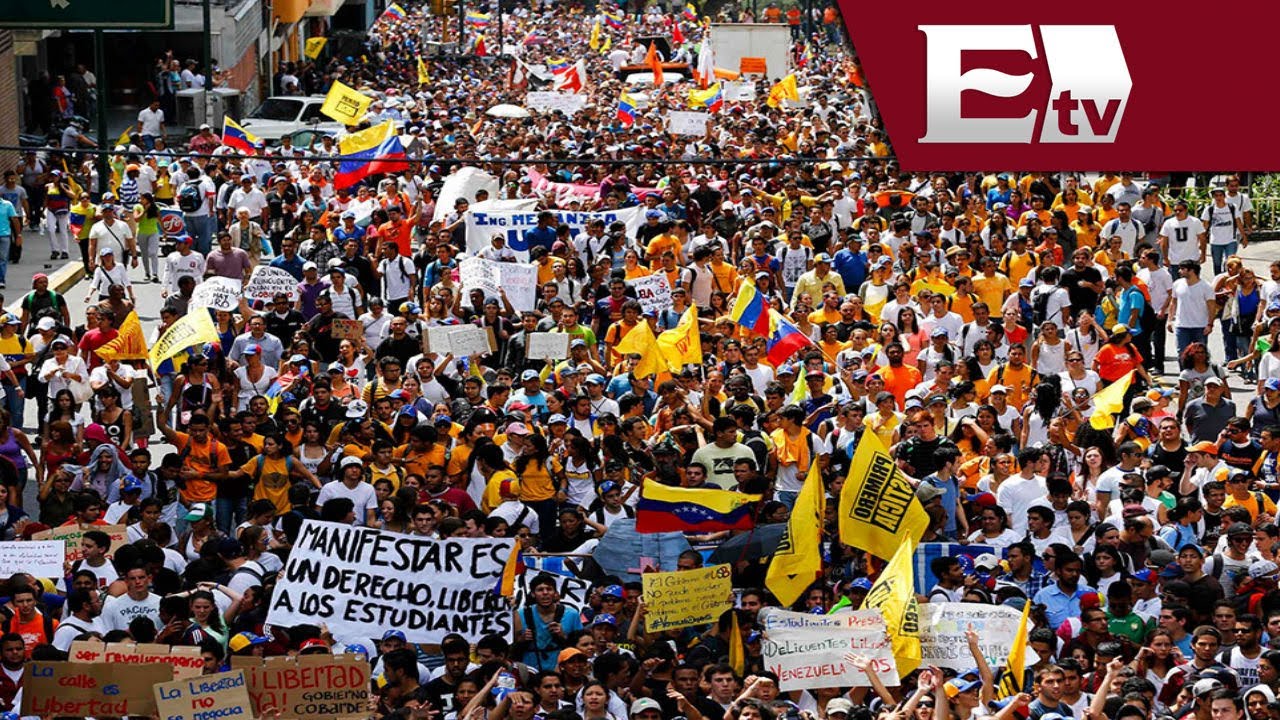Girls, girls, girls.
Colorful moving legs, legs, legs.
Walking away or against my lens.
No sadness in sight, maybe just a little inside…
Girlandia Habana Ltd.
Enrique Colina: Utopian Obstinacy Turns Dreams into a Nightmare / Wendy Iriepa and Ignacio Estrada
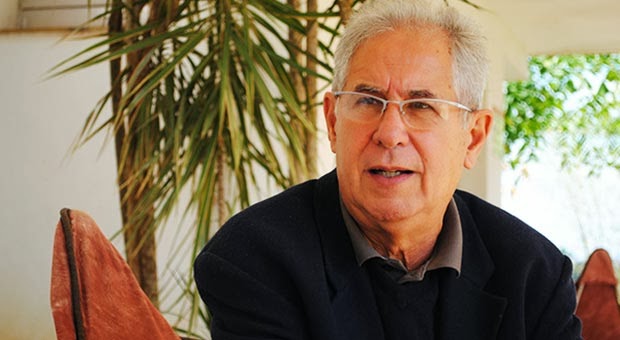
Taken from OnCuba, by Cecilia Crespo
In November last year, the French channel France O aired the documentary “The Marble Cow” by the renowned critic and film producer Enrique Colina. It was only shown once in Cuba, during the last International Festival of New Latin-American Cinema held in Havana.
Some days ago, a Spanish friend who saw Colina’s documentary asked me about Ubre Blanca. For those who do not know, this was a cow that turned into a media phenomenon in the 1980s. In only one day, it produced 110.9 litres of milk and 27,674.2 litres in 365 days of lactation, pushing Arleen, the North American champion, out of the Guinness World Records.
At that time, many people thought that with this cow, Cuba’s economic problems would be solved. The dream fell apart several months later. Colina, a Cuban master of documentaries, took advantage of the story of Ubre Blanca (White Udder) to metaphorically discuss other failed economic plans carried out some decades ago on the island.
Given the insistence of my friend to know more about this documentary, I decided to contact Enrique Colina. We began by talking about “The Marble Cow”, but this wound up being just a pretext for one of the most lucid intellectuals of our country to talk to us about how he sees the present and the future of Cuba.
Tell us about “The Marble Cow” and its relationship to the Cuba that Cubans experience.
The starting point of this film is the never-ending phenomenon of gauging facts that are somehow exceptional and converting them into paradigms of reality. The documentary expresses what one of the people interviewed says about the Cuban press: it is more propaganda than thoughtful, and it does not offer the symptomatic analysis of reality that we need as citizens.
This is currently being demonstrated in what is happening with the exorbitant price of cars. Everyone in the streets is talking about it and nowhere has the media referenced this event. After yet another meeting of the Union of Journalists, in which they all speak in favor of reflecting reality, nothing ever appears in this respect.
The media phenomenon of Ubre Blanca in the 1980s was impressive. Some years after the propaganda paraphernalia that surrounded its appearance I was on the Isla de la Juventud, where I visited the workshop of the sculptors who made the marble cow. It had already been finished for several years and the authorities had not yet decided where to place the sculpture, whether at the entrance to the airport, in a public square, or at Ubre Blanca’s original home. The sculptors were anxious to get the statue out of the workshop because it took up a lot of space.
From that moment I had the idea of making the documentary, in which this cow could become a symbol, a metaphor of a deranged reality. It is a disorder that even today continues to be represented officially in the cult of a hero placed on a pedestal that, even though there is an overflowing trash bin at its base, is always framed so that only the hero and pedestal appear. continue reading
We are living in a time that is the expression of this obstinate deformation and which remains irreversible as long as there is no recognition of the causes and people responsible for the mistakes they have made.
The story of the cow is the magnification of an exceptional natural phenomenon, which, however, does not deny the fact that serious scientific work was done. It was explained that experiments were made to create cattle that were resistant to heat and cows that produced a lot of meat and milk.
In 1981, an extraordinary milk production process was achieved. What happens is that to manage this production with F2 animals, the result of crossings that were made and in which there is a scientific reason and success that I appreciate, there had to be favorable conditions.
A lot of milk was produced in the 1980s because there was economic support to sustain this type of national cattle raising. But this support was due to Soviet help and not to an internal economic structure that reproduced the necessary wealth to sustain this type of plan.
We have lived embracing myths. And one of the aims that I lay out for myself as a filmmaker, in the few years that I may have yet to live, is to contribute to recovering some of the historical memory of this process.
Not the memory of the transcendent facts praised and stained by official rite, but rather the memory of the daily routine of a national life seen from the ground and not from the wishful illusion of disastrous consequences, in other words, those rains that brought the type of mud that is precisely what this documentary is about in a certain way.
Ubre Blanca is also the 10 million ton sugar harvest. It is the Havana Belt, the micro-jet banana, the zeolite… it is a little of all of these economic plans that in a wishful way, and I do not doubt with the best intentions, failed.
Wanting to rapidly detach itself from underdevelopment and without its own wings to fly, reality has referred us to the magic mirror, that of the queen in Snow White, which the generation of filmmakers in the 80s critically compared Cuban television to, until one day the mirror told the queen she was not the fairest of all and she broke the mirror.
Tell me about Cuban cinema. What do you consider to be the positive and negative aspects of current film production in Cuba?
Cuban cinema is composed of different generations and many different views. It is in a delicate state of health due to a lack of material goods, and we all know it is difficult to make a film without money.
But on the other hand, another factor has facilitated filmmaking: the advent of new technologies. They are now talking about the protests made by a group of filmmakers against bureaucratic aspirations to restructure the ICAIC (Cuban Institute of Cinematographic Art and Industry) without consulting the producers.
One of the things protesters are aiming for is the legal recognition of independent production, since the ICAIC does not have the resources it once had when between 6 and 8 full-length films, some fifty newsreels, and other documentaries and animated films were made every year.
This ended, the bubble exploded, and because of this we have to recognize that one has to fight independently, but with a national institution that is neither patronizing nor censorial, but rather a promoter of incentives to maintain and defend, with its collaboration, that film culture that the Revolution stimulated.
I think that interesting things are coming out of this. I recently saw works by two young producers, Melaza and La Piscina, and they seemed quite suggestive. Both expose conflicts in current reality that must be tackled from different esthetic, human, and critical angles.
This new generation has its worries, its sensitivity, and it is facing a very contradictory reality that projects an uncertain future. There are documentaries in the Young Directors Film Festival that reveal this critical, anti-conservative, and polemic view of unstated topics and taboos.They do not turn their backs on conflicts and because of this, because they are uncomfortable, are not made public or shown on television.
Another problem of Cuban cinema is its exhibition. What condition are the cinemas in? Where is the money to equip and repair them? One can make independent films, but what then? Where to show them? They took away private 3D cinemas and what is the alternative? Positive changes have been seen, but all the changes must be recognized as being due to citizen participation, discussion, and forecasting.
Many times measures are taken to stretch and shrink because they do not foresee the consequences of of their decisions. It is as if we are trapped in a cage; the mess is not only material but also ideological, and the modification that we need is not only tactical and partially economic, but also political. Paraphrasing Raúl, the only commitment that Cuban cinema has is to maintain a serious and thoughtful artistic dialogue with the national reality.
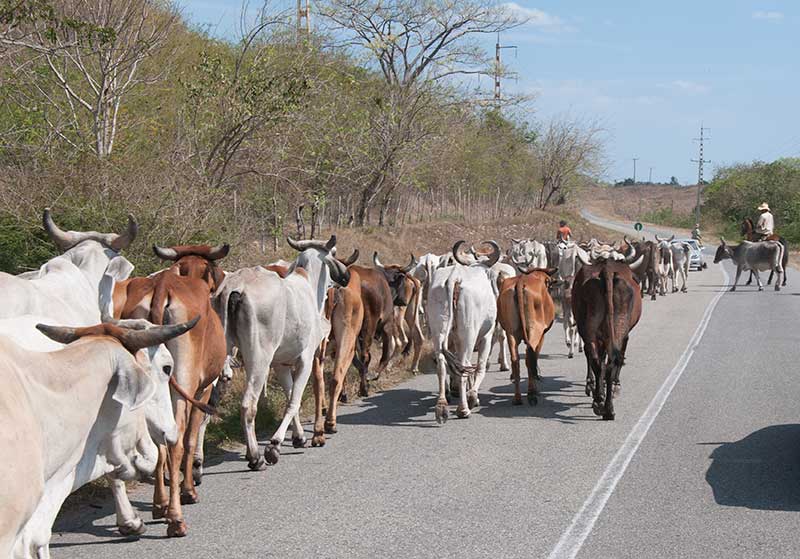 Colina, you speak not only about past, present, and future Cuban cinema, but also about Cuba. Do you consider yourself a filmmaker that questions the society in which you live?
Colina, you speak not only about past, present, and future Cuban cinema, but also about Cuba. Do you consider yourself a filmmaker that questions the society in which you live?
Utopian obstinacy turns dreams into a nightmare if there is no criticism, no debating of ideas. I share the humanist ideas of the Revolution and I obsessively rebel against the practice of its distortion.
In the 1980s, I dealt with esthetics, where I addressed the theme of beauty as a need to reaffirm the human condition. Socialism, in spite of developing education and culture, has always neglected the teaching of esthetic sensibility in the appearance of dynamic urban surroundings.
Today associated with poverty, loyalty has been imposed as an expressive master of the crisis. You see places where everything is ugly and poorly made, which is also reflected as a symptom of distortion in botched jobs and “I will also make you cry”, referring to the poor quality of state services.
In “Neighbors” I highlighted the conflicts of living together and the social indiscipline tolerated by an irresponsible permissiveness, etc. Anyway, I have made different documentaries that reflect problems that already existed in the 80s and which have degraded to terrible levels today.
Beyond calling myself a critic, I think I am a person who lives in this country and who sees this reality clearly and without prejudice at the cost of experiencing bitter disappointment. Far from paralyzing me, it compels me to protest. It seems to me that there is nothing exceptional in what I do. I have an opinion and it is my right to express it.
It is a shame that this attitude is not more widespread. My point of view is that we have made ourselves a type of citizen that has not developed an elemental civic feeling. To be revolutionary has historically meant obeying, following leads, completing the tasks assigned, and it has relegated to demagogic rhetoric that…
Translated by: M. Ouellette
24 January 2014
Huber Matos: “The struggle continues. Viva Cuba Libre!” / CID
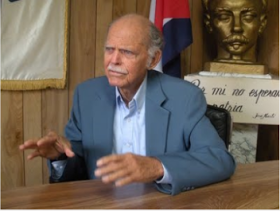

 Huber Matos died on the morning of 27 February in Miami. On the 25th he was admitted to Kendall Regional Hospital where he was diagnosed with a massive heart attack. On the 26th he asked that they withdraw his respirator because he wanted to say goodbye to his wife María Luisa Araluce and to his children and grandchildren. During the day he received calls from Cuba and the main leaders of his party, the Independent and Democratic Cuba (CID) movement, who assured him the organization would not rest until the island is free.
Huber Matos died on the morning of 27 February in Miami. On the 25th he was admitted to Kendall Regional Hospital where he was diagnosed with a massive heart attack. On the 26th he asked that they withdraw his respirator because he wanted to say goodbye to his wife María Luisa Araluce and to his children and grandchildren. During the day he received calls from Cuba and the main leaders of his party, the Independent and Democratic Cuba (CID) movement, who assured him the organization would not rest until the island is free.
Activists in Holguín sang the national anthem to him and members of the organization throughout Cuba were notified of the situation and of the commitment of their leader. His last words were: “The struggle continues. Viva Cuba Libre!”
Huber Matos left a political testament and a letter to Venezuelans. There will be a service for him in Miami on Sunday, 2 March, and he asked to be taken to Costa Rica, the country that sheltered him when he went into exile the first time during the Revolutionary struggle in 1957. It was from Costa Rica where he left for the Sierra Maestra to join the guerrilla war, and to this nation that he returned after spending two decades in prison in 1979.
“I want to return to Cuba from the same land whose people always showed me solidarity and affection, I want to rest in the earth of Costa Rica until Cuba is free and from there go to Yara, to accompany my mother and reunite with my father and with Cubans.”
 Huber Matos Benítez was born in Yara, Cuba, on 26 November 1918. He was a schoolteacher turned Revolutionary from his opposition to the dictatorship of Fulgencio Batista. In 1957, during one of the rebels’ logistical support operations, Matos was captured by Batista’s army in the Sierra Maestra area, but he was able to escape and go into exile in Costa Rica.
Huber Matos Benítez was born in Yara, Cuba, on 26 November 1918. He was a schoolteacher turned Revolutionary from his opposition to the dictatorship of Fulgencio Batista. In 1957, during one of the rebels’ logistical support operations, Matos was captured by Batista’s army in the Sierra Maestra area, but he was able to escape and go into exile in Costa Rica.
There, with the support of president José Figueres, he raised arms with which he landed in a cargo plane in the Sierra Maestra. These arms were decisive for the triumph of the small and poorly equipped Rebel Army against the offensive launched by Batista in 1958. For his courage and leadership in the guerrilla struggle, Matos was the rebel who rose most quickly to commander, as head of the Antonio Guiteras Column 9.
The frequent battles and triumphs of this column converted Huber Matos and his men into a legend. Column 9 was in charge of the siege, surrender and taking of the city of Santiago, a deciding action in the final victory of the revolutionary movement. Photographs of Fidel Castro’s triumphant entry into Havana show Huber Matos and Camilo Cienfuegos at his side.
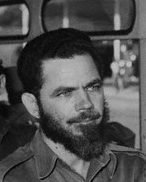 In 1959 Matos was named Army Commander in Camagüey province. After having discussed several times with Fidel Castro the growing alignment of the process with Communism, he renounced it, stating that this constituted a betrayal of the democratic principles of the Revolution as they had been promised to the Cuban people. In response, Castro ordered his arrest on 21 October 1959.
In 1959 Matos was named Army Commander in Camagüey province. After having discussed several times with Fidel Castro the growing alignment of the process with Communism, he renounced it, stating that this constituted a betrayal of the democratic principles of the Revolution as they had been promised to the Cuban people. In response, Castro ordered his arrest on 21 October 1959.
A week after his detention Camilo Cienfuegos, who shared Matos’ concern, mysteriously disappeared with his plane and pilot and they were never found.
During the summary trial for sedition in December 1959, Matos insisted on denouncing the deviation from the objective of the Revolutionary Movement for which he and so many others had risked their lives. He was sentenced to twenty years in prison, which he served in rebellion until the last day in 1979.
When he left prison, a representative of the Costa Rican government traveled to Cuba to accompany him on his trip to Costa Rica, where a large group of Cubans met him at the airport, along with the president Rodrigo Carazo, José Figueres and Oscar Arias.
From exile, he worked tenaciously to denounce the Castro regime. This led him to found, in 1980 in Caracas, Venezuela, the Independent and Democratic Cuba movement (CID), which today has a large membership organized in delegations throughout the entire island. Members of the CID are frequently harassed, imprisoned, and at times tortured by the Cuban authorities.
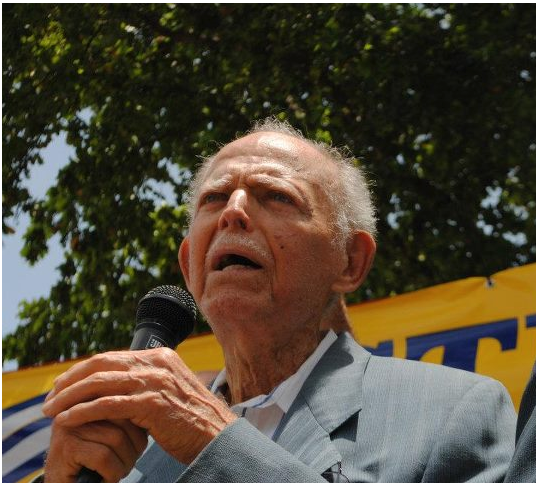 In his autobiographical book “How the Night Came,” which has sold more than 100,000 copies and which circulates clandestinely in Cuba, Matos relates the details of his participation in the Revolutionary army and his subsequent imprisonment, in which he was subjected to every kind of torture.
In his autobiographical book “How the Night Came,” which has sold more than 100,000 copies and which circulates clandestinely in Cuba, Matos relates the details of his participation in the Revolutionary army and his subsequent imprisonment, in which he was subjected to every kind of torture.
As Secretary General of the CID, from his base in Miami, Florida, Huber Matos engaged in intense activity reporting and campaigning in the United States, Latin America and Europe. In 2002 his social-democratic party published the Project of the New Republic, which has five key programmatic fundamentals:
1. Independence and sovereignty
2. Multiparty democracy
3. Free market economy
4. Human rights and social justice.
5. Latin American and continental integration
In addition, in 2011 the CID published a draft Constitution that guarantees the exercise of democratic freedoms and respect for human rights for all the inhabitants of the island, and includes a variety of provisions on education, social welfare, the economy and the environment.
Commander Matos qualified as a teacher in Santiago de Cuba and received a PhD in Teaching from the University of Havana.
Rogelio Matos Araluce 1-321-759-8066, rogeliomatos@gmail.com
Huber Matos Garsault 1-305-906-1950, hubermatos@hotmail.com
27 February 2014
Cuba and the European Union: Oil and Water / Angel Santiesteban
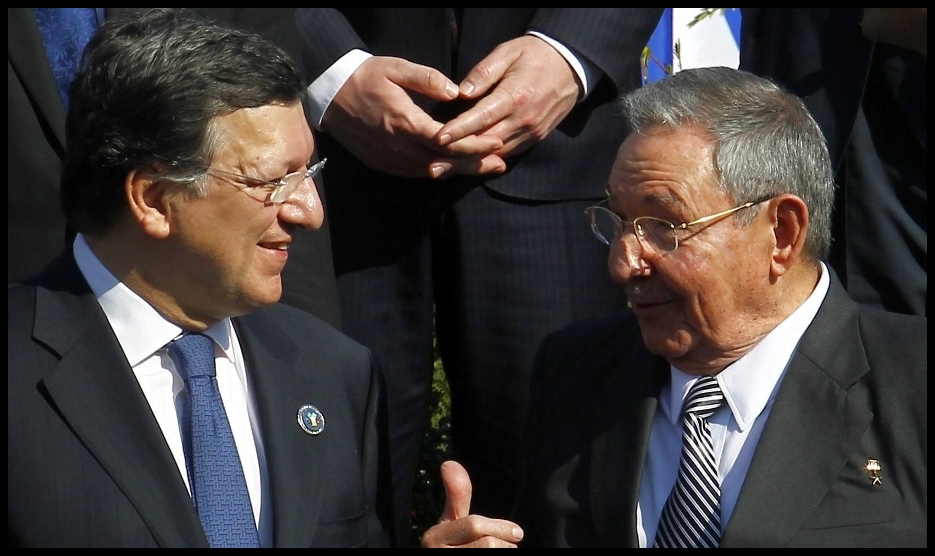 If the European Union only recommends that its chief of diplomacy, Catherine Ashton, “talk” with Havana’s dictatorship, it won’t serve any purpose other than to understand one more time that totalitarian governments cannot transform themselves nor do they want to. Nevertheless the Foreign Ministers have approved “opening up negotiations for a bilateral agreement.”
If the European Union only recommends that its chief of diplomacy, Catherine Ashton, “talk” with Havana’s dictatorship, it won’t serve any purpose other than to understand one more time that totalitarian governments cannot transform themselves nor do they want to. Nevertheless the Foreign Ministers have approved “opening up negotiations for a bilateral agreement.”
Negotiating with the Castro brothers would be a betrayal of the European block itself. The Cuban regime holds an extremist position and won’t cede one iota of its unanimous power. The Universal Rights that the 28 members of the EU proclaim would never be found in the current Cuban system.
What more does the opposition want than to meet the formula that ends the anguish on the archipelago? Although it tries to be optimistic, that possibility seems far away to me, especially when the Cuban regime hasn’t even signed the United Nations Human Rights pacts. Cuba has refused for more than five years to ratify the pacts, justifying itself by saying that first some points in the Constitution must be changed.
Nevertheless, this doesn’t prejudice the members from electing Cuba to the Commission of Human Rights. Thus can cynicism and irony be found at times in politics. Let’s hope that the European Union doesn’t repeat this terrible error, in spite of the lobbying of Cuba’s ambassadors in their countries. continue reading
The European Union, in order to be coherent in foreign politics, first must think about the Cuban people, and then of the millions who can stop profiting from negotiating with a tyranny. The opposite would be to disrespect themselves, and to regress in their foreign policies and position on Universal Human Rights.
Luckily, the wisest words I’ve read on the change of the “Common Position” of the European Union have been those of the President of the European Commission, José Manuel Durao Barroso, who warned the Havana regime that, “It’s very important that Cuba respect human rights, that it release its political prisoners. It’s very important that there be freedom of expression and freedom of association,” Barroso declared before a press conference in Madrid, together with the president of the Spanish government, Mariano Rajoy. The community commissioner emphasized the necessity that “Cuba open itself to values that are completely democratic.”
Personally, disgracefully, I’m not optimistic. I agree with the reservations of Germany and the Czech Republic that Raúl Castro will not respect the idea of democratizing the country, and that he has devised some interplay of political manipulation for the negotiation.
As long as the European Union maintains the principles set forth in the Common Position, it doesn’t have to fear a weakness in its reception abroad, since it understands that for the Cuban government to be flexible on the issue of human rights would weaken its iron grip on the Cuban people, its slaves.
What is clear is that without changes Cuba can only go backwards, because what is certain — we reaffirm — is that the Castro family isn’t thinking of abandoning power, because they behave like a dynasty and believe that power belongs to them by right. The opposition, with international help, must show them they are wrong.
Once again the Cuban people see themselves exposed to different economic interests, without the possibility of having any say in the matter. Let’s pray and fight so that this time is the exception.
Ángel Santiesteban-Prats
Lawton Prison Settlement, February 2014
Please follow the link and sign the petition to have Angel Santiesteban declared a prisoner of conscience by Amnesty International.
Translated by Regina Anavy
26 February 2014
No-one Knows What Fish They are Buying / Ernesto Garcia Diaz

Havana, Cuba – At la Playa de El Chivo (El Chivo beach ), on the northeast coast of Havana, at the foot of the Castillo de los Tres Reyes del Morro (Three Kings Castle), people carry on fishing for sport and business, between the marine waters and sewage, without the health authorities, environmental authorities or the coastguards taking a responsible attitude. The zone receives thousands of cubic metres of polluted water and its sand dunes are deteriorating as a result of the man’s actions.
The grunt, snapper and barber fish, among others, turn the rocky beach into both a centre for boats which arrive every day to seek their economic support; and at best, some people who are enjoying their leisure and are fishing for sport.
This is going on in the mouth of the submerged sewage outlet pipe which runs from the Havana sewage treatment plant, which filters the solid waste coming from the northern and southern collectors of the capital. A concrete pipe of about 375 metres in length crosses Havana Bay, as far as Casablanca, where they pump the dirty water up to La Cabaña, so that it then falls by gravity down to the El Chivo beach, about 150 metres along the coast.
The most astonishing thing is that many fishermen enter into the area of the lower reefs, without any protection, on the edge of where they are fishing in a contaminated area, breathing in the fetid smell from the drain, which keeps the coastal water cloudy with its permanent discharge from the Havana sewers, whose pipes and canals are not lacking in cracks and leaks. continue reading
When it comes to the end result of the activity, various fisherment indicate that they eat the fish themselves, and that they also sell some, but they don’t say where the fish come from.
These citizens, impelled by their desperate need to support themselves and their families, imperil the health of people who are unaware that they are buying a product of uncertain or unknown origin, as many are offered as skinned fillets, or say that they are deep sea fish, which prevents the consumer seeing the physiognomy of the species, so they can at least identify them, in order to avoid the “ciguatera” (tropical fishfood poisoning syndrome ) which is transmitted by the picúa or the aguají, among other species which it is forbidden to fish.
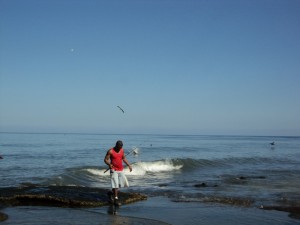
Additionally, on this beach’s rocky and sandy coast, the environment is being damaged by the dumping of plastic handles, fish-hooks, fishing lines, and other discarded items, which are thrown away by people living there or those passing through the area who don’t take any notice of the prohibitions.
Alberto, an ex-fisherman, known as “The Wizard”, admitted that he used to sell fish for a while, but that it was very hard work, always running the risk of a consumer falling ill, because the species caught in this area end up eating the discarded rubbish in the sewage, or a shoal of sardines who have also come over to eat toxic residues.
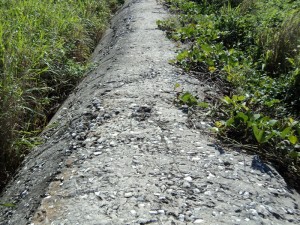
El Chivo Beach, by the Castillo de los Tres Reyes del Morro, classified by UNESCO in 1982 as a World Heritage site, has been converted into a contaminated focal point of bacteria and micro-organisms which can affect the health of those who fish in its waters, pass through there, or consume its fish.
The authorities would be perfectly able to preserve the cleanliness and health of the ecosystem of this sandy coastline, which has been abused and is hardly a good example of sustainable development of a zone of natural, historical and cultural value which should be cared for.
Cubanet, 22 January 2014, Ernesto García Díaz
Translated by GH
Occasional photos… / Luz Escobar
Two Markets – Part 2 / Luz Escobar
Two Markets – Part 1 / Luz Escobar
Economic Independence? / Fernando Damaso
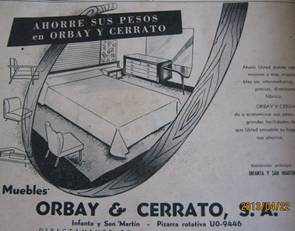 According to official propaganda — intended to validate the experimental economic measures taken during his early years in power and which is repeated incessantly — nationalizations and interventions were aimed at returning the wealth held by foreigners, mostly American, to the people.
According to official propaganda — intended to validate the experimental economic measures taken during his early years in power and which is repeated incessantly — nationalizations and interventions were aimed at returning the wealth held by foreigners, mostly American, to the people.
Statistics show, however, that this was not exactly the case. Those most affected were in fact Cubans, who held between 82% and 85% of the nation’s wealth. This included the entrepreneurial and successful middle class, the principal generator of wealth and employment, most of which was liquidated during the early years. What little remained was finished off during the ludicrous “Revolutionary Offensive” of the 1970s.
In his book, The Owners of Cuba 1958, Guillermo Jiménez focuses on the island’s 551 most influential and powerful families. He notes that only 102 were foreign; the rest were Cuban. In most instances the foreigners were based in Cuba and had Cuban families, including all 65 from Spain. There were 24 Americans, some of whom had Cuban wives and lived in Cuba. At the time the nationalizations took place, the economy was largely in Cuban hands. Some 61.1% of bank deposits were held in Cuban banks, while Cuban-owned sugar processors accounted for 62.2 of daily production, with Americans accounting for 38.4%.
I bring this up because now much is being said and written about the importance of attracting foreign investment to shake the moribund Cuban economy out of its coma. The same government responsible for expelling Cuban investors (who were the majority) and foreign investors (who were the minority), now calls for their return. And what about Cubans? Priority should first be given to Cubans living in Cuba, then to Cubans scattered around the world, and finally to foreigners. Or is it that the authorities do not care about the vaunted economic independence?
It is true that in today’s globalized world no one can pursue economic development on his own, that capital is necessary, no matter where it comes from. But there must be some respect shown to one’s own nationals. At least that is what one expects of intelligent governments which actually look out for the interests of their citizens.
26 February 2014
Declaration of Cuban Civil Society Activists Joining Forces in Madrid
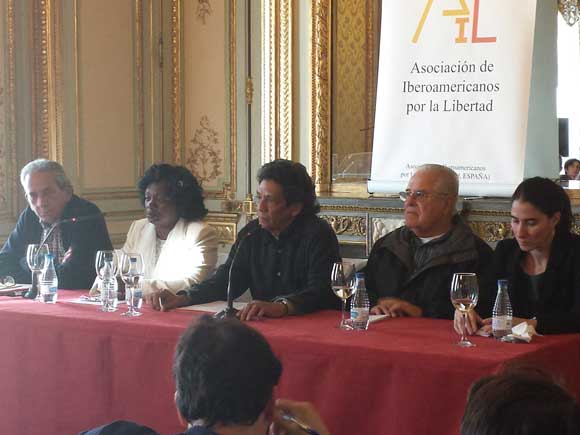
Madrid, February 26, 2014
For recognition of the legitimacy of Cuba’s independent civil society
We, activists of independent civil society, have agreed to promote a representative group to act as a channel of dialogue with international institutions and other potential partners.
Since the ratification of our commitment to peaceful methods to achieve the Rule of Law, we demand from the government of Cuba and before the international community:
1. The unconditional release of all political prisoners , including those under extra-penal license (on parole).
2. The end of political repression, often violent, against the peaceful movement for human rights and pro- democracy.
3. Respect for the international commitments already entered into by the government of Cuba, the ratification – without reservations – of the International Covenants on Human Rights and compliance with ILO conventions on labor and trade union rights.
4. Recognition of the legitimacy of independent Cuban civil society.
Subscribed:
Yoani Sánchez – Blogger
Berta Soler – Spokesperson of the Ladies in White
Elizardo Sanchez – President of the Cuban Commission for Human Rights and Cuban National Reconciliation
Juan Felipe Diaz Medina – Christian Liberation Movement (MCL )
Guillermo Fariñas – UNPACU
Manuel Cuesta Morúa – Progressive Arc
Reinaldo Escobar – Journalist
Antonio Guedes – President of Ibero American Association for Freedom (AIL)
Guillermo Gortázar – President of the Cuban Hispanic Foundation
Javier Larrondo – UNPACU Representative in Spain and EU
Virgilio Toledo – President of Coexistence Spain
Frisia Batista – President of Roots of Hope Spain
Elena Larrinaga – FECU
Alejandro González Raga – Cuban Observatory for Human Rights
Blanca Reyes – Ladies in White
Eduardo Pérez Bengoechea – Coordinator of International Human Rights Platform of Cuba
Tomás Muñoz and Oribe – Cuban Liberal Union
Shelves of Misery / Victor Ariel Gonzalez
The old Carlos III market was transformed into a “mall.” At the beginning, Havanans found a wide selection of merchandise (in CUC — hard currency); today the showcases are empty.
The shelves where the most common ingredients should be found often appear empty or offer only one product of its type without options of quality or size. Those foods that Cubans eat the most are exhausted rapidly, sometimes missing from the shelves for weeks. On the other hand, the most expensive foods stay for sale for so long that many wind up expiring.
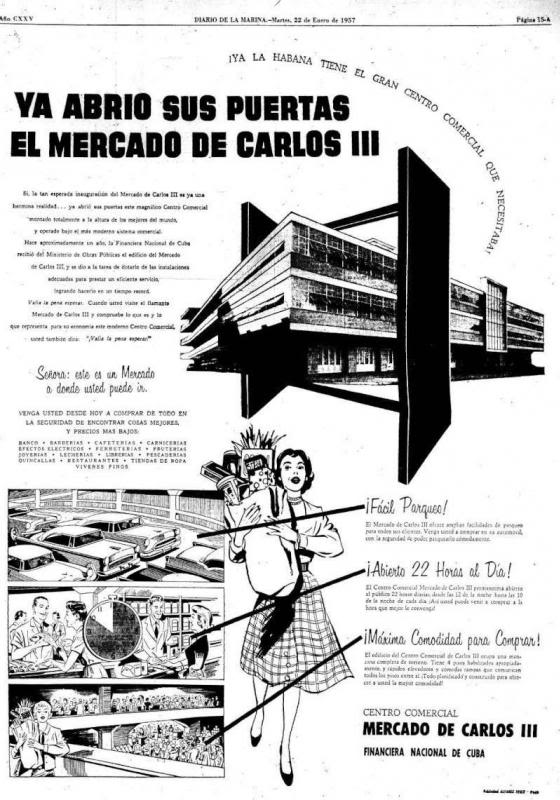
Not to mention the toiletry section. This week there was only one kind of soap for sale, a small bar for 0.25 CUC. The counter where there used to appear dozens of offers for varying budgets now presents a desolate emptiness. continue reading
Another features of the supermarket is the disorganization. It is no surprise that at midday the aisles are full of boxes, piled one on top of the other. “Don’t touch” has been scrawled on them by the establishment’s clerks, who also work as stockers and have neither time nor intention for assisting customers. The boxes that have been empty for hours still wait for someone to retrieve them.
That same disorder is expressed in that the supermarket’s departments have been inconveniently separated: on one side, the meat and dairy where the rotten odor is unbearable, and there are only two types of cheese. There a Cuban resident of Spain visiting the Island comments to this reporter that she has brought all her food from abroad for her stay, and that she is in the place just to buy something for a friend. “I don’t like the quality here,” she confesses is the motive. On the other side is the preserves department as in other stores where packets of coffee or cookies can be obtained. The products may repeat from one department to another.
The lack of sanitation is also seen in the dust on the bottles of wine in the liquor section, one of the most Cuban products offered. The main current suppliers for the shelves of Plaza Carlos III are the Spanish brands Gourmet or Spar, food of national production has almost disappeared.
In this atmosphere, when a humble and fortunate customer in the end has found what he needs, he must confront a long line to pay because one of the two cash registers never works. The difficult mission of obtaining food ends when, at the exit, a character sometimes not in uniform and with a very bad look on his face treats the clients like criminals, being able to search bags shamelessly.
This process is not applied to foreigner who visit the store. This is done to remind Cubans that, as miserable as the shelves of the supermarket are, also miserable is the spirit that the regime has developed.
Cubanet, February 25, 2014 / Victor Ariel Gonzalez
Translated by mlk.
Havana: Castro-McDisney Theme Park / Luis Cino Alvarez
HAVANA, Cuba- Some years ago the American sociologist George Ritzer adopted the perspective of the “McDonaldization of society.” Within this, and thinking of the Disney parks, he coined the term, “McDonaldization of tourism.”
It would be interesting to know Ritzer’s opinion about the great theme park that Cuban has been turned into. Or the several sub-parks that it’s divided into, according to the interests of the visitor.
For ideological tourism, Cuba continues to be the mecca of the world left, now before than yesterday, in the face of the proto-capitalist reforms, they call them “Guidelines,” updating the economic model or as they call it, taking it apart and auctioning off the pieces.
Then, they rush to make the pilgrimage before the Revolutionary story is exhausted, the almendrones (the old American cars) stop rolling, before they tear down the old buildings and the prostitutes and pimps adjust their rates to those of Bangkok or Amsterdam. continue reading
Of the Revolutionary utopia, all that’s left is what the tourists see, planned in advance, and that’s exactly what the guides show them. The tourists don’t like unpleasant surprises or upsets. Before, with unpredictable people, they could ruin their day talking about their troubles; the tourists prefer to talk with happy, helpful people, salsa dancers like they expect them to be, although they can get rude about the tip.
The do indeed assume that here the Revolution doesn’t abandon anyone to their fate, instead of certain crazies and beggars who roam the street, the tourists prefer to take pictures of those who resemble the Comandante, those old guys with the long beard, olive-green shirt, military cap, and licensed by the City Historian as “extras.”
The Havana on sale from Eusebio Leal is like that recorded by Landaluze. A shed to raise hard currency. Tourist postcard folklore. Orthodox mosque and cathedral without worshipers. A garden-cemetery for the rich, with colorful earth and the shadow of a convent. Black-robed fortune tellers with Bayajá scarves.
A virtual Havana, sepia, Technicolor or olive-green: of the wallet and the private taste of each person depending on how they color it.
Cohiba cigars, mojitos and Cuba Libres without Coke. Artisans, guerrilla berets and posters and T-shirts with the fiercely dreamy face of Che Guevara. Pseudo postmodern and almost post-Castro art, just enough to sell well. Salsa and son. Girls and boys for rent: sexy, tanned, healthy and educated at bargain prices.
A picturesque scam just meters from the deep, real Havana. The one that talks loud and swears so as not to explode from rage. The city that smells of the rum and roast pig of hard currency restaurants, with stinking sewers, sweat, grease, coffee mixed with God knows what, dirty reefs and uncollected garbage.
In the midst of the Havana tournament for the crumbs of tourism, foreigners wander around sunburned and laughing, as if they were in the best of all worlds. That other that says it’s possible and that they seem to see embodied in Cuba, where the only annoying thing is the heat.
They roam between the columns, gratings, establishments with first world prices, and buildings in ruins. Dour police in black or grey berets everywhere they look, with their rubber nightsticks and unmuzzled dogs, keeping order. If they exaggerate the task, no matter. They are the guardians of the park, don’t forget, and the place is also under siege by the Yankees, which explains any inconvenience.
Cubanet, 25 February 2014 | Luis Cino Álvarez
Jurassic Cuba / Miriam Celaya
The news agencies don’t have a moment’s rest these days: a satrap in Ukraine has been overthrown through demonstrations and street protests amid the harsh winter, people stand on long lines to see with their own eyes the pomp and pageantry in which the ex-ruler, an ally of Russia, lived.
In Venezuela, student demonstrations continue, supported by opposition leaders finally came together to confront the Maduro government. In Ecuador, the opposition has just delivered a commendable blow to the government authorities by winning an unquestionable majority vote during local elections this Sunday February 23rd in important places like Quito and Guayaquil, putting the brakes on the rampant President of the “citizens’ revolution.”
The world is moving at breakneck speed, changing scenarios and uncovering new players, while we in Cuba remain in the political Jurassic era, with a government of dinosaurs perpetuated in power. continue reading
Judging by the official Cuban press, external reality does not seem to exist, so the “events” may be a gray “syndicate” congress in a country where no syndicates exist, a few “reforms” that do not reform anything, or whatever is dictated by a government that misgoverns a colony of ants that spends its days striving for sustenance, untouched by the joy of the liberated, ignorant of the will and courage of the opponents of Nicolas Maduro, the civility of Ecuadorians who opted for the polls to control the excessive power ambitions of a thug vested as president, and of everything that happens in the world beyond the reefs of a damned Island.
Venezuela hits us especially close, because of its shameless sponsorship by the Cuban dictatorship, obsolete and ruined, extending its evil shadow over a nation rich in natural and human resources. Fortunately for them and for us, Venezuela is not a country of zombies. Nevertheless, it causes sadness and apprehension all at once to see evidence that other peoples are capable of what we are not.
Pity our country, Cuba, whose children choose silence and flight instead of exercising their rights against the olive green satrapy that condemns them to slavery and poverty.
Translated by Norma Whiting
24 February 2014
Communique from the Venezuelan Resistance / Orlando Luis Pardo Lazo
Sunday, February 23, 2014
OFFICIAL COMMUNIQUE NUMBER 1 FROM THE VENEZUELAN NATIONAL RESISTANCE
Resolution concerning the position of Venezuelan citizens who continue street protests against the Castro-Communist regime that operates illegally in Venezuela.
WHEREAS:
The noble people of Venezuela, sick of the treason by the militaristic cabal and Castro-Communism agents who control power, went out February 2, 2014 in the state of Tachira to protest against insecurity, inflation, scarcity and plundering of Venezuelan resources and were repressed and attacked by the repressive forces of the regime, causing dozens of injuries and several detentions.
WHEREAS:
The national discontent, in the face of the oppressive economic crisis unleashed by the Castro-Communist Agent Nicolas Maduro Moros, after the devaluation of the currency, permitting the monthly plundering of a billion dollars in order to maintain and reconstruct the economy of the island of Cuba, attacking and destroying Venezuelan enterprises, subjecting the people to outrageous shortages that keep them demoralized and frustrated in long lines in order to obtain basic products, caused the rest of the country and some 50 cities to join a national protest today converted into a RESISTANCE. continue reading
WHEREAS:
The military, Diosdado Cabello, which occupies the presidency of the National Assembly and the engineer Rafael Ramirez, in the presidency of the PDVSA, are co-authors of the nation’s economic damage, after being the executive arms of each measure that directly benefits them and their corrupt groups embedded in the exchange control authorities.
WHEREAS
The protests that have had a peaceful character and that have been attacked cruelly by armed groups of mercenaries and assassins in the pay of the regime, gathered in the so-called social collectives, identified as Tupamaros, La Piedrita, Carapaicas, and another 92 groups with an average of 100 to 120 members each, have caused hundreds of injuries, damage to private property and residences throughout the country, student deaths, which demonstrates a Terrorist and Assassin State with the purpose of generating fear and chaos in the civil population that today heroically RESISTS in the streets the crimes against humanity to which they have been subjected.
WHEREAS:
Already ten Venezuelan citizens, students, have been assassinated in the streets of Venezuela in the middle of civil and peaceful protests. Crimes committed by the regime’s mercenaries, calling themselves “collectives” or the Bolivarian National Guard, bodies that act together and are what sustain the criminal and traitorous cabal clinging to power.
WHEREAS:
There are hundreds of complaints of unlawful arrests, outside the legal order, warrantless searches, torture of detainees, students subjected to reporting regimes, the illegal incarceration of the citizen Leopoldo Lopez, national leader of the Popular Will party, attacks on political parties and persecution.
WHEREAS:
Amid the regime’s desperation it has sought to develop with the political agents of the opposition, gathered in the Board of Democratic Unity, who call for deposing the civil street protests, offering A DIALOGUE as the only exit from the massive social, economic and political crisis that Venezuela is living through and that said political agents have failed in those efforts.
WHEREAS:
The regime has implemented a ferocious censorship and media manipulation in order to prevent Venezuelan citizens from being up to date on the reality of events, subjecting dailies to newsprint shortages, purchasing through intermediaries audio-visual means of communication, radio and written, using Conatel as a censor entity and repressor of radio broadcasts in almost the whole country in order to try to hide from the world the crimes they are committing.
RESOLVED:
FIRST:
We decide to maintain, intensify and redouble the efforts of the protest action, now become NATIONAL RESISTANCE, until the following objectives are reached:
a) We demand that the members of the armed collectives and those loyal to Castro-Communism be disarmed, investigated and incarcerated and that the para-military action of these groups, which has cost lives, be stopped.
b) We demand that citizens Jose Gregoiro Vielma Mora and Francisco Ameliach, both governors from the states of Tachira and Carabobo, respectively, be subject to immediate investigation for being the masterminds and around whom revolve the action orders of the collective mercenaries who kill students in cold blood.
c) The RESISTANCE in the streets will continue in protest, the petition for SURRENDER AND JAIL for the citizens mentioned in point (b) of the First Resolution.
d) We demand at stop to the regime’s attack on all the productive enterprises established in the country, in all areas. The primary sector, manufacturing and commerce, so that the lines of production may be re-established and to avoid the famine that Venezuela has entered.
e) We demand the criminal and independent investigation of citizen Diosdado Cabello who has been at the front of the military operations of the Bolivarian National Guard against the noble people of Venezuela, committing crimes against humanity, registered and documented, carried out by officials of said repressive body.
f) We demand the removal of all the high command of the Bolivarian National Guard, chiefs of the various detachments, to submit them all to investigation as being suspected of committing war crimes against the people of Venezuela.
g) We demand the removal and criminal investigation of citizen Rafael Ramirez, president of PDVSA, primarily responsible for the economic debacle that lives on in the country, who is at the head of the regime’s economic decisions by being the vice-president of the economic area of the PSUV, singled out as promoting and being part of the corruption in Cadivi, the shipment of oil tankers without any record to criminal regimes like that of Syria, producing inflation and poverty in Venezuela.
h) We demand the irrefutable and non-negotiable surrender of citizen Nicolas Maduro Moros from position as president of the Republic, who must submit himself to investigation and first of all demonstrate his authentic Venezuelan nationality, clarifying to the country with reliable proofs all the events related to the physical disappearance of Lt. Col. Hugo Chavez who held the presidency in order to clear the legality of his ascendance to power being Vice President in the administration of the deceased President. To be investigated in relation to Cuba and the rest of the Latin countries that receive oil perks from Venezuela in order to buy political consciousness and votes in the Organization of American States (OAS). To be investigated for his participation in orders centered on the mercenary collectives to massacre Venezuelan citizens.
i) We demand the FULL LIBERTY of all fellow students and civilians detained in the protests and the investigation of each case of torture, raid or persecution and to establish responsibility and criminal punishments for each soldier implicated.
j) We demand full freedom for all citizens considered political prisoners for years, including the leader of the Popular Will and the end of the persecution of the rest of the leaders of that party.
k) We demand the dismissal of the entire board of directors of Conatel and their prosecution for violating Human Rights in accessing the information of every citizen, after the repressive censorship that it has imposed on the people in the last two weeks.
l) We demand the mass surrender of the High Military Command, generals traitorous to the people of Venezuela, repressors and assassins, suspected of being narco-traffickers, submitted by the foreign military and civil forces of occupation from Cuba.
m) We demand the immediate expulsion from Venezuela of all the Cuban Castro-Communist agents present in the operations against civil, political and economic liberties of Venezuela.
SECOND:
We demand the creation of an Independent National Commission for Criminal Investigation, legally binding, with protection so that it may carry out the investigations that they manage to take before national and international justice according to each case of those responsible for the destruction of Venezuela and the crimes against humanity.
THIRD:
We declare that the Democratic Unity Board (MUD) is not representative of the NATIONAL RESISTANCE, we hold political support in that instance, nevertheless all the protest and resistance operations do not depend on any policy of MUD, by which none is authorized by the demonstrations in the streets to establish dialogues or negotiations with the regime in the name of the RESISTANCE. Any kind of decision that MUD wants to express before the regime must be framed with these points: a through m of the Number One Resolution of this communique.
FOURTH:
We reaffirm that the RESISTANCE will not cede before any kind of negotiation that involves the traitorous members of the country maintaining their positions in power and establishing negotiating tables to investigate and establish penalties. The people of Venezuela remember that this tactic was applied in the 2002-2003 crisis, manipulated by José Vicente Rangel, when he established the Negotiating Table, not allowing the so-called “truth commission” to investigate the events of April 2002, rather they used it to unjustly imprison scapegoats, political prisoners today.
FIFTH:
We urge all civilians, doctors, teachers, professors, public employees, workers, employees, independent civilian, grassroots residents, middle class and wealthy to maintain RESISTANCE IN THE STREETS WITH PEACEFUL PROTEST METHODS AND THAT ARE THAT ARE PART OF THE OPERATIONS THAT HAVE BEEN DEVELOPED TO RESIST THE CRIMINAL SCHEME OF THE CASTRO-COMMUNIST REGIME WHOSE FACE IN VENEZUELA IS NICOLAS MADURO MOROS.
In the streets of Venezuela, on the 23rd of February 2014
Translated by mlk
24 February 2014
Havana Hustling / Ivan Garcia
 This time the phone call came in the middle of the night and the message was grim.
This time the phone call came in the middle of the night and the message was grim.
Edania, a retired teacher who has set up a small business of making phone calls and taking messages for the neighborhood, hurried to give the bad news to a family that lives two doors down from her house, in the rundown neighborhood of La Cuevita in San Miguel del Padrón, in the northern part of Havana.
“The thing is taking off like wildfire,” says Edania. “The retired people can’t afford it, so I decided to take advantage of the fact that I’m one of the few people with a phone in the neighborhood. I started charging one Cuban peso to pass on messages and two pesos for local calls in Havana. If the call is outside the city, I charge 3 pesos per minute. Many people are providing this service, which is one of the officially recognized self-employment businesses, but I have no intention signing up at the tax office. I only get 150 or 200 Cuban pesos per month [$6-8 USD], which barely supplements my meager pension. I don’t charge for funeral news.” continue reading
In the interior of the island as well as in the capital it has become common for neighbors who have telephones to charge for calls. Richard, a retired resident of the Diez de Octubre district of Havana, has a small money box next to his phone with a list of the various call charges.
“I also sell mobile phone cards. I buy them for 10 CUCs [about $11 USD] and sell them for 11; the ones that cost 5 I resell for 6. But apparently someone in the neighborhood has been talking, because the state inspectors have visited me, demanding that I legalize the business. I told them to go to government offices and demand better pensions for the old people, and then come back and see me,” says Richard.
After the vaunted economic reforms in Cuba—an exotic blend of wildly exploitative state capitalism mixed with Marxist speeches and slogans by Fidel Castro—a torrent of quirky trades flooded the Havana neighborhoods.
The elderly are the losers in this wild mixture of everything from sidewalk pastry vendors to high-quality eateries. In the world of self-employment, everything is available.
From people who offer pirated DVDs of Oscar-nominated movies for 25 Cuban pesos, to elderly public-restroom attendants.
In this spectrum of emerging trades, you find “experts” in umbrella repair, button-covering, funeral cosmetology, matchbox-refilling, and shoe repair. For 50 Cuban pesos they’ll carry buckets of water and fill your 60-gallon tank.
Havana is a tropical bazaar. A hive of hustlers. On the avenue that encircles the old port of Havana, a diverse group of citizens converges to try to earn a living.
Right next to Maestranza children’s playground, Delia, decked out in a floral costume, works as an itinerant fortune teller. “I charge ten Cuban pesos for each card-reading. If you want an in-depth session then the price goes up to 25. It’s even more expensive for foreigners, who can afford more.”
Several tourist buses stop at Avenida del Puerto. As the visitors take photos of the Bay and the Christ of Casablanca statue, street musicians sing old boleros and guarachas, trying to attract their attention.
Leonel is one of them. “For 20 years I’ve devoted myself to making soup (singing while the customers ate). There have been good and bad days. But I’ve always made more than the wages the state paid. When no one in Cuba remembered Compay Segundo, Ibrahim Ferrer, or Pio Leyva, God rest their souls, they also had to work as lunchtime entertainers, and to sing in seedy bars. They were lucky that a producer like Ry Cooder lifted them out of poverty,” Leonel said, playing a ranchera as he approached some Mexican tourists, hoping to pass the hat.
A dilapidated port-a-potty, serving as a urinal for the customers of three bayfront bars, is looked after by two rickety old men.
They charge one peso to urinate, three to defecate. “It’s because the toilet is clogged. We have to carry a greater quantity of water,” they say. They get the water for flushing right out of the bay, with a can tied to a rope.
“It’s hard work. We’re here up to twelve hours. But when I get home with 10 or 15 CUCs, I ask the Lord to give me strength to live a few more years so I can help my wife, who’s bedridden after a stroke,” says one of the old men.
The buses are now gone. A quartet of street musicians, all elderly, lean against the sea wall, waiting for new tourists.
“It’s been a long journey to return to the beginning. Before the Revolution I was already a soup peddler. For me nothing has changed. Except that life is more expensive and I’m older,” says the singer and guitarist. His dream is that on some tourist bus, a guy like Ry Cooder will come and rescue him from oblivion.
Iván García
Photo: In central areas of Santiago de Cuba, which like Old Havana are usually frequented by tourists, musicians also look for a living in streets and parks. Taken from Martí News.
Translated by Tomás A.
17 February 2014


